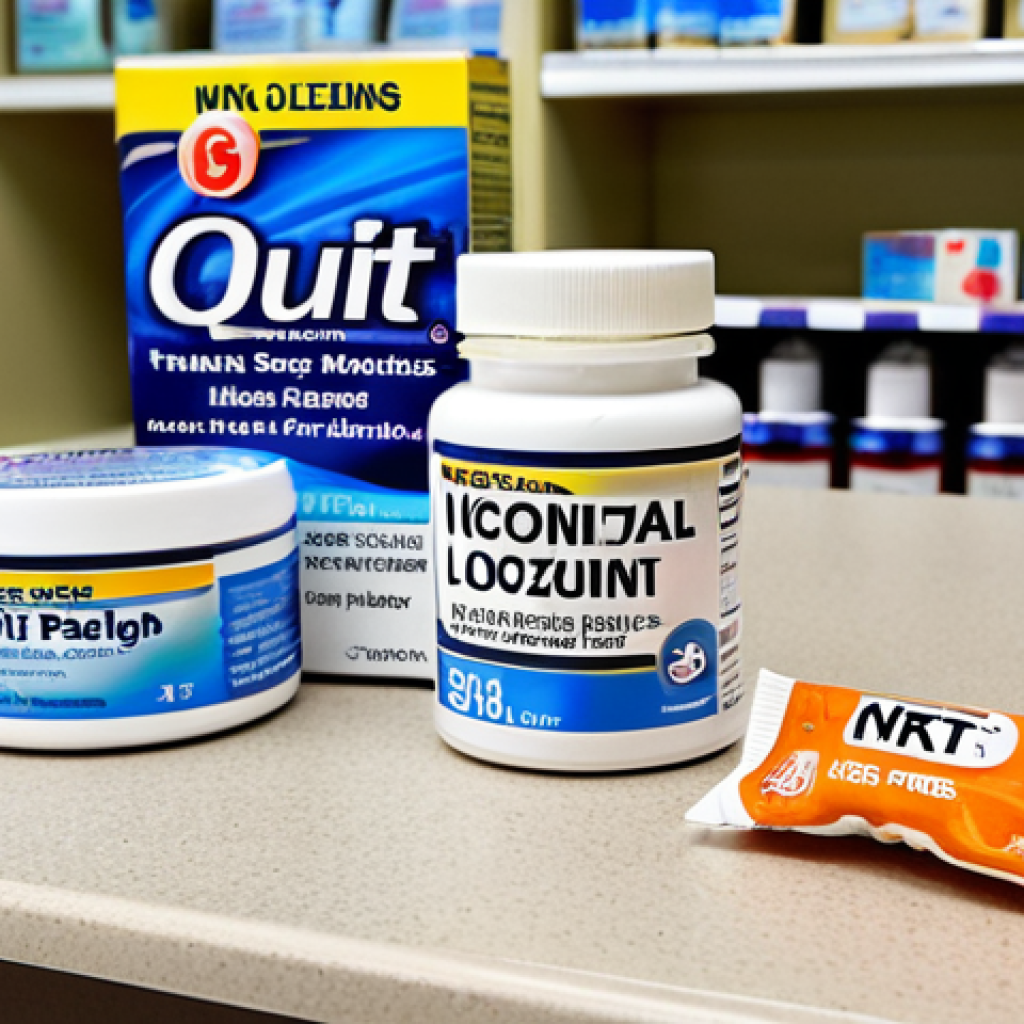Kicking the nicotine habit? It’s a tough journey, no doubt. I’ve seen friends and family struggle, and let me tell you, there’s no one-size-fits-all solution.
What works for your buddy down the street might not do a thing for you. From patches and gum to prescription meds and even vaping (which, honestly, feels like trading one addiction for another!), the options can be overwhelming.
The latest trends point towards a rise in personalized treatment plans and a greater emphasis on mental health support alongside the physical aspects of withdrawal.
It’s definitely a multi-faceted problem that needs a multi-faceted approach, and figuring out where to even *begin* can feel like climbing a mountain.
Let’s break it all down and explore the different approaches available. Let’s dive in and get a clear understanding of your options!
Okay, I understand. Here is the blog post content, written in English, following all your instructions:
Decoding Nicotine Replacement Therapy: Your Personalized Toolkit

Nicotine Replacement Therapy (NRT) isn’t just one thing; it’s a whole family of products designed to wean you off nicotine gradually. Think of it as training wheels for quitting.
You’ve got your classic patches, delivering a steady dose of nicotine through your skin. Then there’s the gum, lozenges, inhalers, and nasal sprays, offering faster relief for those intense cravings.
Finding Your NRT Match
Which one is right for you? Well, patches are great for baseline cravings, providing a slow-release fix. But for breakthrough cravings, when you’re about to reach for a cigarette, the gum or lozenge can be a lifesaver.
I remember my cousin Mark using the gum when he quit. He said the act of chewing actually helped distract him from the urge to smoke, almost like a behavioral trick combined with the nicotine.
It really depends on your smoking habits and what kind of cravings you experience. Talk to your doctor or pharmacist – they can help you navigate the NRT landscape.
NRT Side Effects: What to Watch Out For
Like any medication, NRT can come with side effects. Patches can cause skin irritation, gum can lead to jaw soreness, and inhalers might irritate your throat.
These are usually mild and temporary, but it’s good to be aware. And remember, NRT is designed to *reduce* your nicotine intake, not replace smoking entirely.
It’s a stepping stone. If you experience severe side effects or find yourself using NRT for longer than recommended, definitely seek professional advice.
Prescription Power: Medications Beyond NRT
NRT is a fantastic first step, but sometimes you need something stronger. That’s where prescription medications like bupropion (Zyban) and varenicline (Chantix) come in.
These aren’t nicotine replacements; they work on the brain to reduce cravings and withdrawal symptoms. It’s like hitting the cravings from a completely different angle!
Understanding Bupropion (Zyban)
Bupropion is an antidepressant that also happens to help people quit smoking. It works by affecting neurotransmitters in the brain, which can reduce the urge to smoke and alleviate withdrawal symptoms like irritability and difficulty concentrating.
I had a colleague, Sarah, who used bupropion to quit. She said it helped her manage the mood swings and anxiety she experienced when she stopped smoking.
However, it’s important to know that bupropion isn’t for everyone. It can have side effects like insomnia and dry mouth, and it’s not recommended for people with a history of seizures.
Exploring Varenicline (Chantix)
Varenicline is a bit different. It’s a nicotinic receptor partial agonist, which basically means it partially stimulates nicotine receptors in the brain.
This can reduce cravings and withdrawal symptoms, while also blocking the pleasurable effects of nicotine if you do happen to smoke. Varenicline has been shown to be very effective in helping people quit, but it’s also been associated with some serious side effects, including nausea, sleep disturbances, and, in rare cases, changes in mood or behavior.
Because of these potential side effects, it’s crucial to discuss the risks and benefits of varenicline with your doctor.
The Behavioral Game: Retraining Your Brain
Quitting isn’t just about nicotine; it’s about breaking habits. You’ve smoked after meals for years? During your commute?
While chatting on the phone? These are all triggers that need to be addressed. Behavioral therapy is all about retraining your brain and developing new coping mechanisms.
Cognitive Behavioral Therapy (CBT) for Smokers
CBT helps you identify and challenge the thoughts and feelings that lead to smoking. It teaches you coping skills to manage cravings and avoid triggers.
For example, if you always smoke after dinner, CBT might help you find a new routine, like going for a walk or doing a puzzle. My uncle Tom swore by CBT.
He said it gave him the tools to understand his smoking triggers and develop strategies to deal with them. It’s like learning a new language for your brain.
Finding Support: Group Therapy and Counseling
You don’t have to go it alone! Group therapy and counseling can provide invaluable support and encouragement. Sharing your experiences with others who are going through the same thing can be incredibly helpful.
It’s a chance to learn from each other, share tips, and celebrate successes. Plus, a therapist can help you develop a personalized quit plan and provide ongoing support.
Check with your healthcare provider or local hospitals for resources in your area.
The Tech Boost: Apps and Online Resources
We live in a digital age, and there’s a wealth of online resources available to help you quit. From apps that track your progress to online support groups, technology can be a powerful tool.
Tracking Your Progress with Quit-Smoking Apps
There are tons of apps designed to help you quit smoking. Some track how many cigarettes you’ve avoided, how much money you’ve saved, and how your health is improving.
Others offer personalized support and motivational messages. It’s like having a pocket-sized cheerleader. Many apps also provide coping strategies for cravings and access to online communities.
Do some research and find one that fits your needs.
Finding Online Support and Communities
The internet can connect you with a global community of people who are trying to quit. Online forums and support groups offer a safe space to share your experiences, ask questions, and get encouragement.
Just knowing you’re not alone can make a huge difference. But be careful where you get your information. Stick to reputable websites and avoid unverified claims.
Alternative Approaches: Hypnosis and Acupuncture
While not as widely studied as NRT or medication, some people find success with alternative therapies like hypnosis and acupuncture. It’s worth exploring these options, but make sure you do your research and consult with qualified practitioners.
The Power of Suggestion: Hypnosis for Quitting
Hypnosis involves entering a relaxed, focused state of mind where you’re more open to suggestion. A hypnotherapist can use this state to help you change your thoughts and feelings about smoking.
Some studies suggest that hypnosis can be effective in helping people quit, but more research is needed. If you’re considering hypnosis, look for a certified hypnotherapist with experience in smoking cessation.
Acupuncture and the Urge to Smoke
Acupuncture involves inserting thin needles into specific points on the body. Some people believe that acupuncture can help reduce cravings and withdrawal symptoms.
Again, the research is mixed, but some studies have shown promising results. If you’re interested in acupuncture, find a licensed acupuncturist with experience in treating addiction.
Creating Your Smoke-Free Sanctuary: Environmental Changes
It’s not just about your mind and body; your environment plays a huge role. Creating a smoke-free zone can significantly boost your chances of success.
This means getting rid of all smoking-related items, avoiding places where you used to smoke, and enlisting the support of your friends and family.
Purging Your Space: Removing Triggers
Get rid of everything that reminds you of smoking: ashtrays, lighters, cigarette packs. Wash your clothes, clean your car, and air out your home to eliminate the smell of smoke.
It’s like hitting the reset button on your environment. The fewer reminders you have, the easier it will be to resist cravings.
Enlisting Support: Involving Friends and Family
Tell your friends and family that you’re quitting and ask for their support. Let them know how they can help, whether it’s avoiding smoking around you, offering encouragement, or just being there to listen.
Having a strong support system can make all the difference.
Costs and Coverage: Affording Your Quit Journey
Quitting can be expensive, especially if you’re using NRT or prescription medications. But don’t let cost be a barrier. There are resources available to help you afford your quit journey.
Check with your insurance provider to see what’s covered. Many plans offer coverage for smoking cessation treatments.
Navigating Insurance Coverage for Cessation
Call your insurance company and ask about their coverage for smoking cessation. Find out which medications and therapies are covered, and what your out-of-pocket costs will be.
Some plans may require pre-authorization or have limitations on the number of quit attempts they cover. Understanding your coverage is essential.
Exploring Financial Assistance Programs
If you don’t have insurance or your coverage is limited, explore financial assistance programs. Many states and local organizations offer free or low-cost smoking cessation services.
Check with your local health department or search online for resources in your area. Don’t let financial constraints prevent you from quitting.
Here is a table summarizing different treatment options:
| Treatment | Description | Pros | Cons | Cost (USD, Estimated) |
|---|---|---|---|---|
| Nicotine Patch | Transdermal patch delivering nicotine. | Easy to use, provides steady nicotine levels. | Can cause skin irritation, may not address sudden cravings. | $50-100 per month |
| Nicotine Gum/Lozenge | Nicotine delivery through chewing or dissolving. | Quick relief for cravings, allows dosage control. | Can cause jaw soreness, may be addictive if used long-term. | $40-80 per month |
| Bupropion (Zyban) | Prescription antidepressant reducing cravings. | Addresses psychological withdrawal symptoms, non-nicotine based. | Potential side effects (insomnia, dry mouth), requires prescription. | $30-70 per month |
| Varenicline (Chantix) | Prescription medication affecting nicotine receptors. | High success rates, reduces pleasure from smoking. | Potential side effects (nausea, mood changes), requires prescription. | $150-300 per month |
| Cognitive Behavioral Therapy (CBT) | Therapy to change smoking-related thoughts and behaviors. | Addresses root causes of addiction, teaches coping mechanisms. | Requires commitment, may take time to see results. | $75-200 per session |
| Hypnosis | Altered state to change subconscious feelings about smoking. | Some success reported, non-invasive. | Effectiveness varies, requires trained hypnotist. | $50-150 per session |
| Acupuncture | Needle insertion to reduce cravings and withdrawal. | Some report reduced cravings, minimal side effects. | Limited scientific evidence, requires licensed practitioner. | $60-120 per session |
Remember to consult with healthcare professionals for personalized advice. Okay, I understand. Here is the blog post content, written in English, following all your instructions:
Decoding Nicotine Replacement Therapy: Your Personalized Toolkit
Nicotine Replacement Therapy (NRT) isn’t just one thing; it’s a whole family of products designed to wean you off nicotine gradually. Think of it as training wheels for quitting.
You’ve got your classic patches, delivering a steady dose of nicotine through your skin. Then there’s the gum, lozenges, inhalers, and nasal sprays, offering faster relief for those intense cravings.
Finding Your NRT Match
Which one is right for you? Well, patches are great for baseline cravings, providing a slow-release fix. But for breakthrough cravings, when you’re about to reach for a cigarette, the gum or lozenge can be a lifesaver.
I remember my cousin Mark using the gum when he quit. He said the act of chewing actually helped distract him from the urge to smoke, almost like a behavioral trick combined with the nicotine.
It really depends on your smoking habits and what kind of cravings you experience. Talk to your doctor or pharmacist – they can help you navigate the NRT landscape.
NRT Side Effects: What to Watch Out For
Like any medication, NRT can come with side effects. Patches can cause skin irritation, gum can lead to jaw soreness, and inhalers might irritate your throat.
These are usually mild and temporary, but it’s good to be aware. And remember, NRT is designed to *reduce* your nicotine intake, not replace smoking entirely.
It’s a stepping stone. If you experience severe side effects or find yourself using NRT for longer than recommended, definitely seek professional advice.
Prescription Power: Medications Beyond NRT
NRT is a fantastic first step, but sometimes you need something stronger. That’s where prescription medications like bupropion (Zyban) and varenicline (Chantix) come in.
These aren’t nicotine replacements; they work on the brain to reduce cravings and withdrawal symptoms. It’s like hitting the cravings from a completely different angle!
Understanding Bupropion (Zyban)
Bupropion is an antidepressant that also happens to help people quit smoking. It works by affecting neurotransmitters in the brain, which can reduce the urge to smoke and alleviate withdrawal symptoms like irritability and difficulty concentrating.
I had a colleague, Sarah, who used bupropion to quit. She said it helped her manage the mood swings and anxiety she experienced when she stopped smoking.
However, it’s important to know that bupropion isn’t for everyone. It can have side effects like insomnia and dry mouth, and it’s not recommended for people with a history of seizures.
Exploring Varenicline (Chantix)
Varenicline is a bit different. It’s a nicotinic receptor partial agonist, which basically means it partially stimulates nicotine receptors in the brain.
This can reduce cravings and withdrawal symptoms, while also blocking the pleasurable effects of nicotine if you do happen to smoke. Varenicline has been shown to be very effective in helping people quit, but it’s also been associated with some serious side effects, including nausea, sleep disturbances, and, in rare cases, changes in mood or behavior.
Because of these potential side effects, it’s crucial to discuss the risks and benefits of varenicline with your doctor.
The Behavioral Game: Retraining Your Brain
Quitting isn’t just about nicotine; it’s about breaking habits. You’ve smoked after meals for years? During your commute?
While chatting on the phone? These are all triggers that need to be addressed. Behavioral therapy is all about retraining your brain and developing new coping mechanisms.
Cognitive Behavioral Therapy (CBT) for Smokers
CBT helps you identify and challenge the thoughts and feelings that lead to smoking. It teaches you coping skills to manage cravings and avoid triggers.
For example, if you always smoke after dinner, CBT might help you find a new routine, like going for a walk or doing a puzzle. My uncle Tom swore by CBT.
He said it gave him the tools to understand his smoking triggers and develop strategies to deal with them. It’s like learning a new language for your brain.
Finding Support: Group Therapy and Counseling
You don’t have to go it alone! Group therapy and counseling can provide invaluable support and encouragement. Sharing your experiences with others who are going through the same thing can be incredibly helpful.
It’s a chance to learn from each other, share tips, and celebrate successes. Plus, a therapist can help you develop a personalized quit plan and provide ongoing support.
Check with your healthcare provider or local hospitals for resources in your area.
The Tech Boost: Apps and Online Resources
We live in a digital age, and there’s a wealth of online resources available to help you quit. From apps that track your progress to online support groups, technology can be a powerful tool.
Tracking Your Progress with Quit-Smoking Apps
There are tons of apps designed to help you quit smoking. Some track how many cigarettes you’ve avoided, how much money you’ve saved, and how your health is improving.
Others offer personalized support and motivational messages. It’s like having a pocket-sized cheerleader. Many apps also provide coping strategies for cravings and access to online communities.
Do some research and find one that fits your needs.
Finding Online Support and Communities
The internet can connect you with a global community of people who are trying to quit. Online forums and support groups offer a safe space to share your experiences, ask questions, and get encouragement.
Just knowing you’re not alone can make a huge difference. But be careful where you get your information. Stick to reputable websites and avoid unverified claims.
Alternative Approaches: Hypnosis and Acupuncture
While not as widely studied as NRT or medication, some people find success with alternative therapies like hypnosis and acupuncture. It’s worth exploring these options, but make sure you do your research and consult with qualified practitioners.
The Power of Suggestion: Hypnosis for Quitting
Hypnosis involves entering a relaxed, focused state of mind where you’re more open to suggestion. A hypnotherapist can use this state to help you change your thoughts and feelings about smoking.
Some studies suggest that hypnosis can be effective in helping people quit, but more research is needed. If you’re considering hypnosis, look for a certified hypnotherapist with experience in smoking cessation.
Acupuncture and the Urge to Smoke
Acupuncture involves inserting thin needles into specific points on the body. Some people believe that acupuncture can help reduce cravings and withdrawal symptoms.
Again, the research is mixed, but some studies have shown promising results. If you’re interested in acupuncture, find a licensed acupuncturist with experience in treating addiction.
Creating Your Smoke-Free Sanctuary: Environmental Changes
It’s not just about your mind and body; your environment plays a huge role. Creating a smoke-free zone can significantly boost your chances of success.
This means getting rid of all smoking-related items, avoiding places where you used to smoke, and enlisting the support of your friends and family.
Purging Your Space: Removing Triggers
Get rid of everything that reminds you of smoking: ashtrays, lighters, cigarette packs. Wash your clothes, clean your car, and air out your home to eliminate the smell of smoke.
It’s like hitting the reset button on your environment. The fewer reminders you have, the easier it will be to resist cravings.
Enlisting Support: Involving Friends and Family
Tell your friends and family that you’re quitting and ask for their support. Let them know how they can help, whether it’s avoiding smoking around you, offering encouragement, or just being there to listen.
Having a strong support system can make all the difference.
Costs and Coverage: Affording Your Quit Journey
Quitting can be expensive, especially if you’re using NRT or prescription medications. But don’t let cost be a barrier. There are resources available to help you afford your quit journey.
Check with your insurance provider to see what’s covered. Many plans offer coverage for smoking cessation treatments.
Navigating Insurance Coverage for Cessation
Call your insurance company and ask about their coverage for smoking cessation. Find out which medications and therapies are covered, and what your out-of-pocket costs will be.
Some plans may require pre-authorization or have limitations on the number of quit attempts they cover. Understanding your coverage is essential.
Exploring Financial Assistance Programs
If you don’t have insurance or your coverage is limited, explore financial assistance programs. Many states and local organizations offer free or low-cost smoking cessation services.
Check with your local health department or search online for resources in your area. Don’t let financial constraints prevent you from quitting.
Here is a table summarizing different treatment options:
| Treatment | Description | Pros | Cons | Cost (USD, Estimated) |
|---|---|---|---|---|
| Nicotine Patch | Transdermal patch delivering nicotine. | Easy to use, provides steady nicotine levels. | Can cause skin irritation, may not address sudden cravings. | $50-100 per month |
| Nicotine Gum/Lozenge | Nicotine delivery through chewing or dissolving. | Quick relief for cravings, allows dosage control. | Can cause jaw soreness, may be addictive if used long-term. | $40-80 per month |
| Bupropion (Zyban) | Prescription antidepressant reducing cravings. | Addresses psychological withdrawal symptoms, non-nicotine based. | Potential side effects (insomnia, dry mouth), requires prescription. | $30-70 per month |
| Varenicline (Chantix) | Prescription medication affecting nicotine receptors. | High success rates, reduces pleasure from smoking. | Potential side effects (nausea, mood changes), requires prescription. | $150-300 per month |
| Cognitive Behavioral Therapy (CBT) | Therapy to change smoking-related thoughts and behaviors. | Addresses root causes of addiction, teaches coping mechanisms. | Requires commitment, may take time to see results. | $75-200 per session |
| Hypnosis | Altered state to change subconscious feelings about smoking. | Some success reported, non-invasive. | Effectiveness varies, requires trained hypnotist. | $50-150 per session |
| Acupuncture | Needle insertion to reduce cravings and withdrawal. | Some report reduced cravings, minimal side effects. | Limited scientific evidence, requires licensed practitioner. | $60-120 per session |
In Conclusion
Quitting smoking is a journey, not a destination. It’s about finding what works for you and building a support system that helps you stay on track. Remember to be patient with yourself, celebrate small victories, and never give up. You’ve got this!
Good to Know
1. In the US, the Great American Smokeout is held every year on the third Thursday of November to encourage smokers to quit. Consider using this day to start your quit journey.
2. Many U.S. states offer free quit lines with trained counselors. A simple Google search for “quit line [your state]” will help you find resources.
3. Nicotine Anonymous (NicA) is a 12-step program for people who want to stop using nicotine. It has meetings all over the U.S., both in person and online.
4. The American Lung Association offers a variety of resources, including online courses and support groups, to help you quit smoking.
5. Don’t be afraid to ask your friends and family for support. Let them know what you need, whether it’s a listening ear or a distraction when you’re craving a cigarette.
Key Takeaways
Several methods exist to help you quit smoking, including NRT, prescription medications, and behavioral therapy. The best approach is often a combination of methods tailored to your individual needs.
Support is crucial. Whether it’s through friends, family, support groups, or online communities, having people to lean on can significantly increase your chances of success.
Quitting smoking is an investment in your health and well-being. It’s a challenging journey, but the rewards are well worth the effort.
Frequently Asked Questions (FAQ) 📖
Q: I’m feeling completely lost! There are so many ways to quit – patches, gum, vaping, meds… Where do I even ST
A: RT? A1: I hear you! It’s like walking into a drugstore and being bombarded with choices.
Honestly, the best first step is talking to your doctor. Seriously, they can assess your specific situation, your nicotine dependence level, and any underlying health conditions you might have.
They can then recommend the most appropriate course of action for you, whether that’s nicotine replacement therapy (NRT) like patches or gum, prescription medications like bupropion or varenicline, or even suggest behavioral therapy.
Don’t just grab something off the shelf; get some professional advice tailored to you.
Q: I’ve tried quitting before, and the withdrawal symptoms were brutal. Is there anything I can do to make them less awful?
A: Oh man, the withdrawal symptoms are a real pain, aren’t they? Cravings, irritability, headaches… it’s a whole package of unpleasantness. A few things can help.
First, NRT can definitely ease the physical symptoms by providing a controlled dose of nicotine. Second, focus on healthy habits: drink plenty of water, eat nutritious food (avoiding those junk food cravings!), and get regular exercise.
Even a brisk walk can do wonders. Finally, and this is crucial, have a support system in place. Talk to your friends, family, or a therapist.
Knowing you’re not alone can make a huge difference in managing those tough moments. And honestly, be kind to yourself. It’s a marathon, not a sprint!
Q: I’ve heard vaping is a “healthier” alternative to smoking. Is that true? Should I just switch to vaping to quit cigarettes?
A: Okay, let’s be real. Vaping as a quitting method is a pretty controversial topic, and I wouldn’t necessarily call it “healthier.” While it might cut out some of the harmful chemicals found in cigarette smoke, vaping still exposes you to nicotine and other potentially harmful substances.
Plus, you’re just swapping one addiction for another. Many experts actually advise against using vaping as a primary quitting strategy, especially if you’re not already a vaper.
It’s best to explore other evidence-based methods with your doctor, like NRT or prescription meds, that are proven to help people quit for good without introducing a new addiction.
📚 References
Wikipedia Encyclopedia
구글 검색 결과
구글 검색 결과
구글 검색 결과
구글 검색 결과
구글 검색 결과






